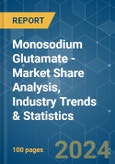The Monosodium Glutamate Market size is estimated at USD 6.15 billion in 2024, and is expected to reach USD 7.48 billion by 2029, growing at a CAGR of 4.01% during the forecast period (2024-2029).
The COVID-19 pandemic's difficult times negatively impacted the food and beverage industry. The international restrictions on MSG have damaged the food service industry and the MSG distribution chain. On the other hand, MSG consumption relatively showed a decent growth as the usage of processed foods has increased. During the COVID outbreak, stores and online marketplaces could stock up on processed goods in anticipation of sales, ensuring a consistent supply of MSG to its vendors.
One of the monosodium glutamate market's driving factors is the fast food outlet establishment and rising demand for fast food chains, which is predicted to enhance the market's growth due to the high demand for convenience meals and changing lifestyles around the world. Furthermore, the younger generation has a growing desire for taste, leading manufacturers to offer products with improved monosodium glutamate flavors.
The growing popularity of Asian food and the need for salt substitutes is transforming the global culinary scene. Thereby, MSG supply in Western countries has increased due to glutamate salt consumption, particularly in meat and other protein-rich goods.
As this industry's import and export percentages are low, all worldwide manufacturers are committed to growing their businesses and upgrading their business to this product to capture the target market. International corporations, such as Ajinomoto, have established plants in China.
This product will be delivered within 2 business days.
The COVID-19 pandemic's difficult times negatively impacted the food and beverage industry. The international restrictions on MSG have damaged the food service industry and the MSG distribution chain. On the other hand, MSG consumption relatively showed a decent growth as the usage of processed foods has increased. During the COVID outbreak, stores and online marketplaces could stock up on processed goods in anticipation of sales, ensuring a consistent supply of MSG to its vendors.
One of the monosodium glutamate market's driving factors is the fast food outlet establishment and rising demand for fast food chains, which is predicted to enhance the market's growth due to the high demand for convenience meals and changing lifestyles around the world. Furthermore, the younger generation has a growing desire for taste, leading manufacturers to offer products with improved monosodium glutamate flavors.
The growing popularity of Asian food and the need for salt substitutes is transforming the global culinary scene. Thereby, MSG supply in Western countries has increased due to glutamate salt consumption, particularly in meat and other protein-rich goods.
Monosodium Glutamate (MSG) Market Trends
Rising Demand for Ready -To-Eat and Processed Food
Monosodium glutamate volume has increased due to the widespread usage of MSG in processed food manufacturing. In addition, an increase in the consumption of ready-to-eat and other processed meals is also a major factor responsible for the increased demand and production of MSG. Nowadays, as consumers are short on time and like to buy simple and quick things, it allows many large companies and new age manufacturers to enter the " Ready-to-eat" and "Ready-to-cook" food markets. Key players are striving to enter into the potential prospects of the food sector to foster innovation, adapt to quality measures, and boost usability to create such pre-cooked ready-to-eat foods and related opportunities in the Market.Asia-Pacific Witnessing a Prominent Share
China is a major producer of MSG, which is supplied to countries such as India, Thailand, and Indonesia, among others. MSG is a flavor enhancer in food items such as soups, canned vegetables, and processed meats. Its import demand has increased due to the growing demand for processed foods in developing nations such as India. Furthermore, as the need for flavor enhancers grows in developed countries, countries such as the United States and Russia are among the top importers of MSG from China and Indonesia.As this industry's import and export percentages are low, all worldwide manufacturers are committed to growing their businesses and upgrading their business to this product to capture the target market. International corporations, such as Ajinomoto, have established plants in China.
Monosodium Glutamate (MSG) Industry Overview
Key participants in the MSG market include Ajinomoto Co. Inc. and COFCO, which are expanding into previously unexplored potential markets like the United States, Russia, the Netherlands, and other countries by catering to rising consumer needs. These corporations, like others, are implementing expansion and investment plans to improve and expand their customer base. Expansions, acquisitions, and collaborations are the most common methods used by companies in the global MSG market.Additional Benefits:
- The market estimate (ME) sheet in Excel format
- 3 months of analyst support
This product will be delivered within 2 business days.
Table of Contents
1 INTRODUCTION
4 MARKET DYNAMICS
5 MARKET SEGMENTATION
6 COMPETITIVE LANDSCAPE
Companies Mentioned (Partial List)
A selection of companies mentioned in this report includes, but is not limited to:
- Ajinomoto Co. Inc
- COFCO
- Ningxia Eppen Biotech Co. Ltd
- Fufeng Group
- Meihua Holdings Group Co. Ltd
- Gremount International Company Limited
- Cargill Incorporated
- Shandong Qilu Biotechnology Group Co.
- Henan Lotus Flower Gourmet Powder Co.
- Shandong Xinle Monosodium Glutamate Limited Company
Methodology

LOADING...










